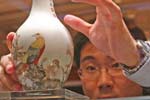Dan Steinbock
Laying BRICS for new edifice
Updated: 2011-04-13 07:55
By Dan Steinbock (China Daily)
On April 14, President Hu Jintao will meet with Brazilian President Dilma Rousseff, Russian President Dmitry Medvedev, Indian Prime Minister Manmohan Singh and South African President Jacob Zuma. The third formal meeting of BRIC (Brazil, Russia, India, and China) includes South Africa for the first time.
In the past, the advanced economies empowered the world economy. Today, large emerging economies drive global growth. In the emerging world, the future is a source of hope and optimism. In the advanced world, it is often a cause for ambivalence and resignation. In the long run, however, the rise of the large emerging economies is vital to global peace and prosperity.
In the early 2000s, Goldman Sachs projected that China's total GDP would catch up with the US' by 2042. After the past decade and the global financial crisis, however, the pace of transition has accelerated. Now it appears that China's GDP may match that of the US by the early 2020s.
The global crisis and the debt burden of the advanced economies will tax their growth for years to come, whereas the BRIC economies may grow twice as fast. And these large emerging economies are followed by "mini-BRICs", including Indonesia, the Philippines, Egypt, Turkey, Vietnam and Nigeria.
A strong BRIC growth does not require "economic miracles". But it does presume macroeconomic stability, relatively high investment rates and trade openness, increasing technological capabilities, growing emphasis on human capital, and political stability.
Now Africa has a representative in the BRIC alignment. In the future, some North African and Middle Eastern countries, too, may join the BRIC league. In the postwar era, Egypt, led by Gamal Abdel Nasser, emerged as the leader of the Arab world. But the gains of globalization have largely bypassed Egypt and its 80 million people despite the great economic potential. In 1980, Egyptians on average were almost 65 percent more prosperous than Chinese. Last year, the Chinese were 15 percent more prosperous than the Egyptians, at purchasing power parity.
One of the most remarkable aspects of the rise of the BRIC economies is the severed tie between total GDP and per capita GDP, that is, the economic power of nations and the average prosperity of their citizens. In the past, the two used to go hand in hand. In the future, that will no longer be the case.
Specials

Share your China stories!
Foreign readers are invited to share your China stories.

Art auctions
China accounted for 33% of global fine art sales.

Waiting for drivers' seat
Lack of sponsorship appears to be why Chinese drivers have yet to race in a Formula 1 event



